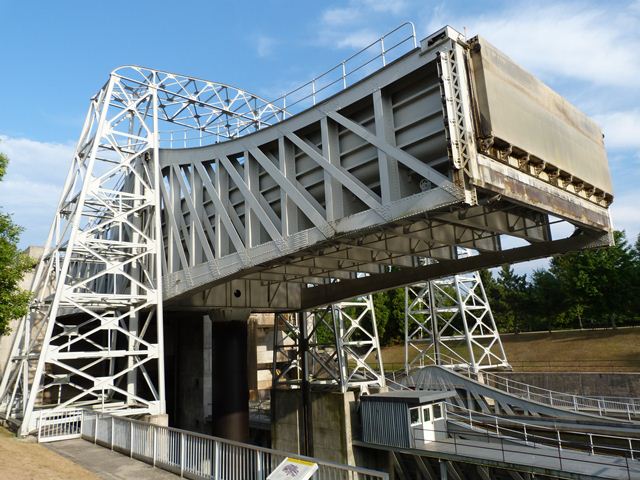We Recommend:
Bach Steel - Experts at historic truss bridge restoration.
Kirkfield Lift Lock

Primary Photographer(s): Nathan Holth and Rick McOmber
Bridge Documented: July 21, 2012
Trent-Severn Waterway Over Trent-Severn Waterway and Kirkfield Road
Rural: Kawartha Lakes City, Ontario: Canada
1907 By Builder/Contractor: Dominion Bridge Company of Montréal, Québec and Engineer/Design: Richard Birdsall Rogers
1969
Not Available
139.1 Feet (42.4 Meters)
33.1 Feet (10.09 Meters)
1 Main Span(s)
Not Applicable

View Information About HSR Ratings
Bridge Documentation
About The Lift Lock
The Kirkfield Lift Lock is not a bridge, however this impressive structure that has two structures that physically raise and lower to move boats through a change in elevation on the Trent-Severn Waterway has a number of features similar to and of interest to bridge enthusiasts. The lock structures that raise and lower utilize a riveted pony truss design to bear the load of the water they contain. There are also trussed towers next to the locks that resemble the towers used on vertical lift bridges The steel on the lift lock towers is also noteworthy since it also contains a couple interesting and very well-preserved and visible British steel brands. British steel is exceedingly rare in North America, but can be found on a small number of surviving Canadian heritage bridges, and obviously was used on this lift lock as well.
This lift lock has been the victim of substantial alteration from the original design. Most significant is the structure that includes an overpass over Kirkfield Road was completely demolished and replaced in 1969.
The photo gallery for this structure has photos of some of the interpretive signage around the lift lock. Consult these images for details on how the lift lock works. In short, the two locks and the water they hold balance and counterweight each other. Small changes in the amount of water in one lock will cause one lock to lift and at the same time lower the other lock.
This lift lock is one of two on the Trent-Severn Canal. The other one in Peterborough is older, larger, and less altered, however note that it lacks the trussed towers and uses concrete instead.
Portland Cement In The Trent-Severn Canal Lift Locks
Gord Young, Editor for Lakefield Heritage Research provided the following detailed discussion which explains why the Kirkfield Lift Lock has the trussed steel towers instead of concrete, and the significance of the Portland Cement that was used in the Peterborough Lift Lock.
The Peterborough Lift Lock is the largest and tallest compressed Portland cement structure in the world. We know this, because test walls created at the Lakefield Portland Cement Company's former property have the highest density Portland cement recorded. Kirkfield Lift Lock on the other hand had to substitute a steel cage using the same shape as that at Peterborough, only because Rogers and later, Grant who replaced Rogers, could not get adequate "on-time" deliveries of the Lakefield Portland Cement Company. Something was wrong with the materials coming out of a Portland cement plant that was created near Kirkfield to try to alleviate the problem. Nothing worked for Grant. He threw up his hands and built the steel-caging instead. The design for Peterborough and Kirkfield was based on the Peavey-Haglin grain elevator in St. Paul MN. Only two things changed from the grain elevator to the lift locks. The concrete forms were squared, and, the Portland cement was compressed after being poured. Haglin's grain elevator was a simple Portland pour. Both lift locks and the grain elevator used the same principle of pour a form and then jack-up the form when the lower-half was nearly set. Rogers had a certain amount of Portland cement poured into the form, then had it tamped until it was nearly dry, poured more, tamped, poured more, tamped, then when full, began jacking up the form. Now that the outer slathing-parging has peeled off, you can see the ridges of the pouring forms.
![]()
Photo Galleries and Videos: Kirkfield Lift Lock
Bridge Photo-Documentation
Original / Full Size PhotosA collection of overview and detail photos. This gallery offers photos in the highest available resolution and file size in a touch-friendly popup viewer.
Alternatively, Browse Without Using Viewer
![]()
Bridge Photo-Documentation
Mobile Optimized PhotosA collection of overview and detail photos. This gallery features data-friendly, fast-loading photos in a touch-friendly popup viewer.
Alternatively, Browse Without Using Viewer
![]()
Maps and Links: Kirkfield Lift Lock
Coordinates (Latitude, Longitude):
Search For Additional Bridge Listings:
Additional Maps:
Google Streetview (If Available)
GeoHack (Additional Links and Coordinates)
Apple Maps (Via DuckDuckGo Search)
Apple Maps (Apple devices only)
Android: Open Location In Your Map or GPS App
Flickr Gallery (Find Nearby Photos)
Wikimedia Commons (Find Nearby Photos)
Directions Via Sygic For Android
Directions Via Sygic For iOS and Android Dolphin Browser

